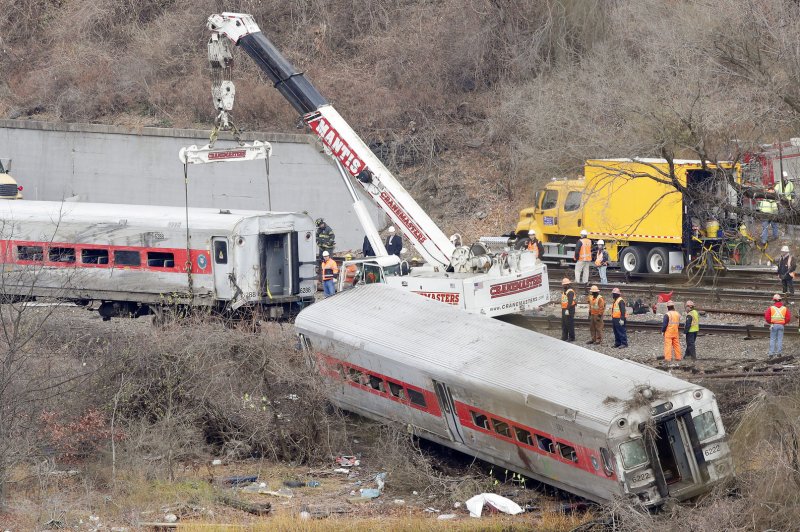1 of 7 | Crews, Investigators and Police lift and remove sections of a Metro-North Train after it derailed on route to Grand Central Station the day before in New York City on December 2, 2013. At least four people were killed and dozens injured after the Metro-North passenger train derailed on a sharp curve in the Bronx borough of New York City on Sunday morning. UPI/John Angelillo |
License Photo
Dec. 2 (UPI) -- The commuter rail train that derailed Sunday morning in the Bronx was going more than 50 mph faster than it should have been at the time of the crash, investigators from the National Transportation Safety Board said Monday.
Four people were killed and nearly 70 people injured when five of the train's cars went careening off the tracks and nearly into the Hudson River, near the Spuyten Duyvil station in the Bronx.
The train was traveling at 82 mph at the time of the crash, in a 30 mph stretch of track, exceeding even the 70 mph maximum speed of the relative straightaway before the curve. It was still unclear if the speed was due to human error or equipment failure, said NTSB member Earl Weener.
Officials recovered both of the train's recording devices -- similar to an airplane's black boxes -- in the investigation into the crash, the first causing passenger fatalities in Metro-North's 30-year history. The recorders said the pressure on the throttle did not drop until a mere six seconds before the train went off the rails, "very late in the game," Weener said.
The train's engineer, William Rockefeller, said he tried to "dump the breaks" before the train derailed, a maneuver meant to stop the train in an emergency. But people familiar with the investigation said the maneuver should not have been necessary in the first place, as the train should have been slowing down well before it hit the curve.
NTSB investigators are interviewing Rockefeller, a longtime Metro-North veteran with a good record, and have completed drug and alcohol tests. Investigators were also examining his cellphone activity.
The four fatalities were identified as James Lovell, 58, Donna F. Smith, 54, James Ferrari, 59 and Kisook Ahn, 35.
The accident was the second this year for Metro-North, when a train crashed in Bridgeport, Conn., in May, when 76 people were injured.
[Wall Street Journal]
[New York Times]







